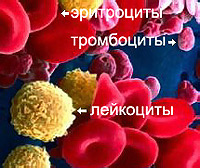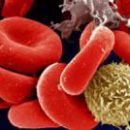Leukosis or leukemia is a rapidly developing bone marrow disease, in which the uncontrolled accumulation of immature white blood cells in the bone marrow, peripheral blood and various internal organs occurs. Fall ill like adults and children.
Content
Leukemia (leukemia) is a malignant disease of white bloodthly. The disease occurs in the bone marrow, and then applies to blood, lymph nodes, spleen, liver, central nervous system (CNS) and other organs. Leukemia may arise both in children and in adults.
Leukemia is a complex disease and has many different types and subtypes. The type of treatment and the outcome of the disease varies widely depending on the type of leukemia and other individual factors.
Circuit and lymphatic systems
To understand the various types of leukemia, it is useful to have basic information about blood and lymphatic systems.
Bone marrow - This is soft, spongy, the inner part of the bones. All blood cells are produced in the bone marrow. In babies, the bone marrow is found in almost all bones of the body. To adolescence, the bone marrow is preserved mainly in flat bones of skull, blades, ribs, pelvis.
The bone marrow contains blood-forming cells, fat cells and fabrics, helping the growth of blood cells. Early (primitive) blood cells are called stem cells. These stem cells grow (ripen) in a certain order and produce red blood tales (red blood cells), white blood tales (leukocytes) and platelets.
 Erythrocytes blood tolerate oxygen from the lungs to other body fabrics. They also derive carbon dioxide, spent product activity product. Reducing the number of blood erythrocytes (anemia, anemia) causes weakness, shortness of breath and increased fatigue.
Erythrocytes blood tolerate oxygen from the lungs to other body fabrics. They also derive carbon dioxide, spent product activity product. Reducing the number of blood erythrocytes (anemia, anemia) causes weakness, shortness of breath and increased fatigue.
Leukocytes Blood helps protect the body from microbes, bacteria and viruses. Three main types of leukocytes are distinguished: granulocytes, monocytes and lymphocytes. Each type plays a special role in protecting the body against infection.
Thrombocytes Prevent bleeding during cuts and bruises.
Lymphatic system consists of lymphatic vessels, lymph nodes and lymphs.
Lymphatic vessels Remind Vienna, but do not bond, but transparent liquid -Limf.
Lymph consists of excess tissue fluid, productivity products and immune system cells.
The lymph nodes (Sometimes referred to as lymphatic glands) - legged bodies located along the lymphatic vessels. Lymph nodes contain the cells of the immune system. They can increase in size more often when inflammation, especially in children, however, sometimes their increase can be a sign of leukemia, when the tumor process went beyond the bone marrow.
What causes sharp leukemia and is it possible to prevent them
Risk factor is something that increases the likelihood of disease. From some risk factors, such as smoking, you can get rid of. Other factors, such as age, cannot be changed.
Smoking is a proven risk factor in acute myeloid leukemia (IML). Although many people know that smoking causes lung cancer, only some understand that smoking can affect cells, not directly contact with smoke.
Cancer substances and contained in tobacco smoke penetrate the bloodstream and apply to the body. One fifth cases of OML is caused by smoking. Smoking people should attempt to stop smoking.
There are some environmental factors that are associated with the development of acute leukemia. For example, long-term contact with gasoline is a risk factor for an OML, and the impact of high doses of radiation (the explosion of an atomic bomb or an incident with a nuclear reactor) increases the risk of oml and acute lymphoblastic leukemia (All).
In people who suffered from other malignant tumors and received some antitumor drugs, the risk of an OML increased. Most of these cases of the IML arises within 9 years after the treatment of Hodgkin's disease (lymphogranulosetosis), non-Hodgkinsky lymphoma (lymphosarcom), all or other malignant tumors, such as breast cancer and ovarian.
There is a certain concern about high-voltage gear lines as a risk factor leukose. According to some data, in these situations, the risk of leukemia is not elevated or increased slightly. One thing is clear that most cases of leukemia are not related to high-voltage gear lines.
In a small number of people suffering from very rare diseases or HTLV-1 virus, the risk of acute leukemia is increased.
However, most people with leukemia have no risk factors. The reason for their disease remains unknown to the present. Due to the fact that the cause of leukemia is unclear, then there are no ways of prevention, with the exception of two important points: avoid smoking and contact with substances causing cancer, for example, gasoline.
As leukemia is classified
With most tumors, the stages of the disease (I, II, III and IV) are distinguished, which are based on the sizes of the tumor and its prevalence. Such staging is not suitable for leukes, because leukemia is a disease of blood cells, in which tumor education is usually not formed.
Leukosis amazes the whole bone marrow and in many cases by the time of diagnosis already involves the other organs in the process. With leukemia, laboratory studies of tumor cells allow them to clarify their characteristics that help in assessing the outcome (forecast) of the disease and the choice of treatment tactics.
Three subtypes of acute lymphoblastic leukemia and eight subtypes of acute myeloid leukemia were isolated.
Various types of leukemia
The four main types of leukemia are distinguished:
- acute compared to chronic
- lymphoblastic compared to myeloid
«Spicy» means rapidly developing. Although cells grow quickly, they are not able to risk properly.
«Chronic» means the state when the cells look mature, but, in fact, they are pathological (modified). These cells live too long and replace some types of leukocytes.
«Lymphoblastic» and «Myeloid» Indicates two different types of cells from which leukemia originated. Lymphoblastic leukemia develops from bone marrow lymphocytes, myeloid leukemia arises from granulocytes or monocytes.
Leukemoses may arise both in children and in adults, however, different types of leukemia prevail in one or other groups.
Acute lymphoblastic leukemia (all)
- Occurs in children and adults;
- More often diagnosed in children;
- It is a few more than half of all cases of leukemia in children.
Acute myeloid leukemia (OML) (often called acute non-lismodity leukemia)
- Strikes children and adults;
- Is less than half of all cases of leukemia in children.
Chronic lymphocytic leukemia (CLL)
- It is found only in adults;
- Received twice as often as chronic myeloid leukemia (HML).
Chronic myeloid leukemia (HML)
- Basically strikes adults and very rarely detected in children;
- Diagnosed in two less often hl.









